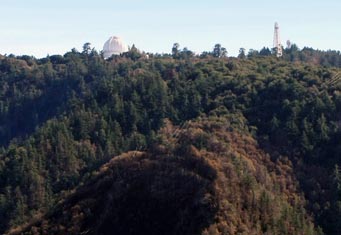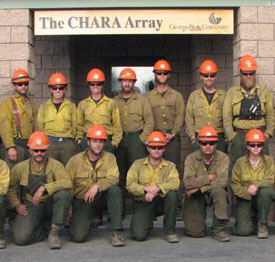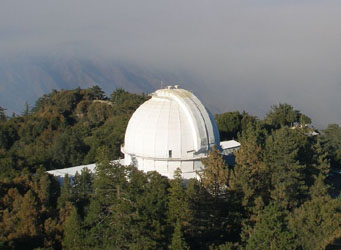| Editor's Note: A whole year has passed since the largest wildfire ever in Los Angeles County history threatened to destroy Mount Wilson Observatory, a century-old icon of astronomy that looks out over the city from the mountain's 5,715-foot-high summit. SkyandTelescope.com provided anxious stargazers the world with frequent updates on the close brush with tragedy, and we've asked observatory director Hal McAlister to reflect on the event. |
Late on the afternoon of Wednesday, August 26, 2009, Larry Webster, site manager for the CHARA interferometer array on Mount Wilson's summit, sent around a brief email message: "A new fire broke out on the lower Angeles Crest Hwy at about 15:20 today."

The severity of Southern California's Station Fire is evident in this 2-hour sequence of images recorded by a webcam at Mount Wilson Observatory as the Sun set on August 29, 2009.
UCLA Dept. of Physics and Astronomy
The next few weeks were a roller-coaster ride of alternating despair and relief until, finally, on September 25th, we could declare the observatory safe from any further danger. We'd been spared due to a combination of wonderful expertise, energy, and determination of the hundreds of firefighters who protected the observatory during those weeks, as well as by the vagaries of a fire that seemed to run out of steam just short of the summit's ridgeline. But to our north and west, as far as the eye could see, it left behind an obliterated, ashen landscape.

Scorched earth at lower left attests to how close the Station Fire came to the summit of Mount Wilson and to its historic 100-inch reflector (dome at left) and solar-tower telescope. Click on the image for a larger view.
Dave Jurasevich
People have asked me "How close did it get?" A sweep of flame came upslope just to the northwest of the 100-inch telescope dome. Fortunately, that was extinguished by water-dropping aircraft, but I estimate that it came to within 500 to 700 yards of telescope W1 of the six-telescope CHARA array. Had the drop not occurred, W1 would surely have been consumed. The W2 telescope and the old "Bunk House," used by the builders of the 100-inch telescope dome, would have been next to go. Then the fire would have swept to the east, taking out CHARA telescopes E1 and E2 as well as a house used by scientists on the mountain. I could go on imagining this frightful scenario, but clearly this was indeed a very, very close call for Mount Wilson.
Clean up of the observatory grounds began quickly after officials allowed our staff back on the mountain, and observing was back in full swing by October 1st. Fire retardant, foam-like when applied but flaky once dried, had to be washed and brushed off some buildings and removed from the ground — a small price to pay for the protection it provided during the crisis. No facilities of any kind were damaged, and in fact firefighters left the observatory grounds more secure than had been the case beforehand.
To defend our site, they'd aggressively removed trees and brush near structures and set backfires to consume the accumulated fluff that could otherwise ignite and send flames climbing up trees. Some trees were killed as a result of these controlled burns; they'll be removed this fall. We plan to undertake additional clearing and thinning as funding permits.

Members of the Helena Hotshots pause for a group shot in front of the CHARA building atop Mount Wilson. Click on the image to see the full team, along with observatory director Hal McAlister at far left and team leader Fred Thompson at far right.
David Jurasevich
While we recovered quickly from the effects of the fire itself, the massive mud- and rockslides triggered by very heavy winter rains continue to impact our operations. The Angeles Crest Highway, the main artery into the mountains from the Los Angeles basin, washed out in three locations.
During one of the first mud "events," one of our telescope operators got trapped as she drove down in the middle of the night. Alone and anxious, she had to hike 5 miles in the dark before reaching an unstaffed fire station, where she called for assistance. Then it took the California Highway Patrol another eight hours to assist her, as another slide had blocked the road farther down the mountain.
Angeles Crest Highway is not expected to reopen until November. Our staff, who mostly live in and near Pasadena, now have a 100-mile roundtrip commute. Even for Angelinos, that's horrible. We have no mail or parcel deliveries to the mountain. If we can entice service providers to come up to make repairs, we pay a heavy premium for our temporary remoteness. But all this will pass; more importantly, our mountain did not burn, and, miraculously, the forest is beginning to green up.

Despite dense smoke in the distance, the dome of Mount Wilson's historic 100-inch telescope was unscathed by Southern California's devastating Station Fire. (Image taken late afternoon on September 6, 2009.)
UCLA Dept. of Physics and Astronomy
We're moving forward. Mount Wilson Observatory is six years into its second century. We have ambitious plans to build a wonderful new visitor center to tell the Mount Wilson story and to reawaken Southern California and the nation to the site's unrivaled scientific heritage.
This summer, we opened our Cosmic Café, a sandwich shop near the entrance to the observatory. So, if you're in the area and want to take an interesting drive through a recovering national forest, head up to Mount Wilson. Enjoy a fine lunch, then stroll back to the observatory itself, admire the telescope domes and towers, and imagine what might have been . . .
Harold A. McAlister is Regents' Professor of Astronomy at Georgia State University and director of GSU's Center for High Angular Resolution Astronomy, which operates the CHARA array on Mount Wilson. He also heads the Mount Wilson Institute, which manages Mount Wilson Observatory under an agreement with the Carnegie Institution of Washington. The blog he kept during the Station Fire will soon be issued as an Amazon Kindle book entitled Diary of a Fire.
Editor's Note: The observatory has struggled financially while recovering from the fire. Click here if you'd like to contribute to its recovery fund.
 0
0









Comments
You must be logged in to post a comment.